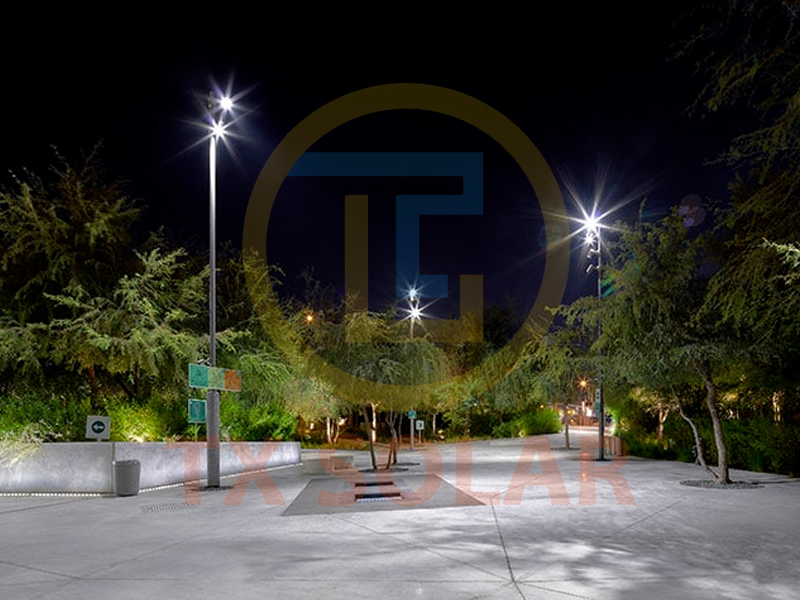Park lighting design is an important aspect of creating safe and inviting outdoor spaces for visitors. As LED technology advances, there are now more options than ever for creating efficient and beautiful lighting solutions for parks. In this article, we’ll explore the key considerations and best practices for designing park lighting using LED luminaires.
1. Understand the purpose of park lighting
Before diving into the design process, it’s important to understand the primary goals of park lighting. Lighting serves a variety of purposes in a park environment, including enhancing safety, creating a welcoming atmosphere, and highlighting key features of the landscape. LED lighting is ideal for parks because of its energy efficiency, long life, and ability to create a variety of lighting effects.
2. Evaluate the layout and features of the park
The first step in designing park lighting is to evaluate the layout and features of the park. Pay attention to pathways, seating areas, entertainment features, and any natural elements such as trees, water features, or sculptures. Understanding the layout of the park will help determine which areas need lighting and the specific lighting needs of each space.
3. Security plan
When designing park lighting, safety should be your top priority. LED fixtures can be strategically placed to illuminate pathways, entrances and parking lots, ensuring visitors can safely walk around the park even after dark. In addition, well-lit spaces can deter potential criminal activity, thereby enhancing the overall security of the park.
4. Improve energy efficiency with LED lighting
LED technology has revolutionized outdoor lighting with its energy-saving and long-lasting properties. When designing park lighting, choose LED fixtures to minimize energy consumption and reduce maintenance costs. LED fixtures also provide excellent light quality and can be dimmed or programmed for automatic control, further increasing their efficiency.
5. Enhance the beauty of the park
In addition to safety and functionality, park lighting can enhance the overall aesthetics of your park. LED lights come in a variety of styles and color temperatures, allowing designers to create visually appealing lighting effects. Consider using warm white LEDs to create a cozy and welcoming atmosphere in seating areas, while cool white LEDs can be used to emphasize architectural elements or natural features.
6. Incorporate sustainable design practices
Sustainability is a growing concern in outdoor lighting design. LED fixtures consume less energy and produce minimal light pollution, consistent with sustainable design practices. When designing your park lighting, consider using solar-powered LED fixtures or utilizing smart lighting controls to further reduce energy consumption and minimize your park’s environmental impact.
7. Consider your surroundings
When designing park lighting, it is important to consider the surrounding environment and its impact on the lighting design. Consider any adjacent properties, wildlife habitat and the natural night sky. LED fixtures can minimize light spill and glare, maintaining the natural darkness of the surrounding environment while still providing ample illumination within the park.
8. Implement a flexible lighting plan
Parks are vibrant spaces that host a variety of events and activities throughout the year. When designing park lighting, flexible lighting solutions must be developed to adapt to different usage scenarios. LED fixtures with adjustable brightness and color options can accommodate a variety of events, such as evening concerts, outdoor fitness classes, or seasonal celebrations.
9. Seek expertise
Designing park lighting using LED fixtures requires a thoughtful and strategic approach. It is recommended to seek the expertise of a lighting designer or consultant who specializes in outdoor lighting. These professionals can provide valuable insight, recommend appropriate LED fixtures, and develop a comprehensive lighting plan based on the park’s specific needs and characteristics.
10. Regular maintenance and monitoring
After a park lighting design is implemented, it is critical to develop a maintenance and monitoring plan to ensure the continued performance of LED fixtures. Regular inspections, cleaning and minor repairs will help extend the life of your fixtures and maintain optimal lighting conditions throughout your park.
In summary, designing park lighting using LED luminaires requires a holistic approach that considers safety, energy efficiency, aesthetics, sustainability and adaptability. By carefully evaluating the park’s layout, utilizing LED technology, and incorporating best practices, designers can create a light-filled, engaging outdoor space that enhances the overall park visitor experience. With the right combination of creativity and technical expertise, LED park lighting can transform a park into a vibrant and welcoming environment day or night.
If you need to design park lighting, please feel free to contact us for a complete design proposal.
Post time: Sep-04-2024

